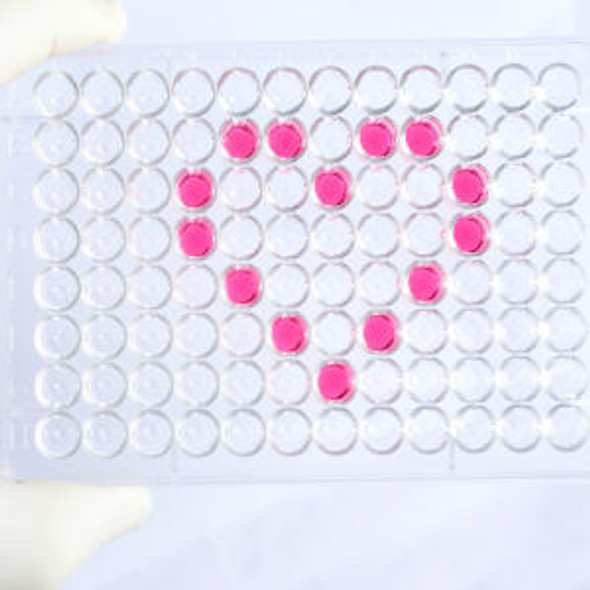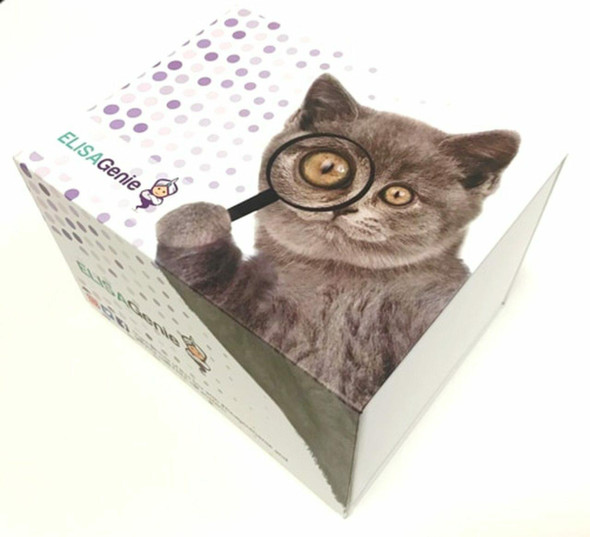Human Cell Biology ELISA Kits 1
Human ACTN4 (Actinin Alpha 4) ELISA Kit (HUES02638)
- SKU:
- HUES02638
- Product Type:
- ELISA Kit
- Size:
- 96 Assays
- Uniprot:
- O43707
- Sensitivity:
- 0.47ng/mL
- Range:
- 0.78-50ng/mL
- ELISA Type:
- Sandwich
- Synonyms:
- FSGS, FSGS1
- Reactivity:
- Human
- Sample Type:
- Serum, plasma and other biological fluids
- Research Area:
- Cell Biology
Description
| Assay type: | Sandwich |
| Format: | 96T |
| Assay time: | 4.5h |
| Reactivity: | Human |
| Detection Method: | Colormetric |
| Detection Range: | 0.78-50 ng/mL |
| Sensitivity: | 0.47 ng/mL |
| Sample Volume Required Per Well: | 100µL |
| Sample Type: | Serum, plasma and other biological fluids |
| Specificity: | This kit recognizes Human ACTN4 in samples. No significant cross-reactivity or interference between Human ACTN4 and analogues was observed. |
This ELISA kit uses Sandwich-ELISA as the method. The micro ELISA plate provided in this kit has been pre-coated with an antibody specific to Human ACTN4. Standards or samples are added to the appropriate micro ELISA plate wells and combined with the specific antibody. Then a biotinylated detection antibody specific for Human ACTN4 and Avidin-Horseradish Peroxidase (HRP) conjugate are added to each micro plate well successively and incubated. Free components are washed away. The substrate solution is added to each well. Only those wells that contain Human ACTN4, biotinylated detection antibody and Avidin-HRP conjugate will appear blue in color. The enzyme-substrate reaction is terminated by adding Stop Solution and the color turns yellow. The optical density (OD) is measured spectrophotometrically at a wavelength of 450 nm ± 2 nm. The OD value is proportional to the concentration of Human ACTN4. The concentration of Human ACTN4 in samples can be calculated by comparing the OD of the samples to the standard curve.
| UniProt Protein Function: | ACTN4: F-actin cross-linking protein which is thought to anchor actin to a variety of intracellular structures. This is a bundling protein. Probably involved in vesicular trafficking via its association with the CART complex. The CART complex is necessary for efficient transferrin receptor recycling but not for EGFR degradation. Defects in ACTN4 are the cause of focal segmental glomerulosclerosis type 1 (FSGS1). A renal pathology defined by the presence of segmental sclerosis in glomeruli and resulting in proteinuria, reduced glomerular filtration rate and edema. Renal insufficiency often progresses to end-stage renal disease, a highly morbid state requiring either dialysis therapy or kidney transplantation. Belongs to the alpha-actinin family. |
| UniProt Protein Details: | Protein type:Motility/polarity/chemotaxis; Cytoskeletal Chromosomal Location of Human Ortholog: 19q13 Cellular Component: cortical cytoskeleton; extracellular space; neuron projection; focal adhesion; protein complex; perinuclear region of cytoplasm; cytoplasm; stress fiber; extracellular region; intercellular junction; pseudopodium; Z disc; ribonucleoprotein complex; nucleus Molecular Function:actin filament binding; integrin binding; protein binding; protein homodimerization activity; ligand-dependent nuclear receptor transcription coactivator activity; retinoic acid receptor binding; nucleoside binding; protein N-terminus binding; calcium ion binding; actin binding; nuclear hormone receptor binding Biological Process: regulation of apoptosis; retinoic acid receptor signaling pathway; platelet activation; actin filament bundle formation; protein transport; platelet degranulation; response to hypoxia; negative regulation of cell motility; positive regulation of cell motility; positive regulation of sodium:hydrogen antiporter activity; positive regulation of pinocytosis; blood coagulation Disease: Focal Segmental Glomerulosclerosis 1 |
| NCBI Summary: | Alpha actinins belong to the spectrin gene superfamily which represents a diverse group of cytoskeletal proteins, including the alpha and beta spectrins and dystrophins. Alpha actinin is an actin-binding protein with multiple roles in different cell types. In nonmuscle cells, the cytoskeletal isoform is found along microfilament bundles and adherens-type junctions, where it is involved in binding actin to the membrane. In contrast, skeletal, cardiac, and smooth muscle isoforms are localized to the Z-disc and analogous dense bodies, where they help anchor the myofibrillar actin filaments. This gene encodes a nonmuscle, alpha actinin isoform which is concentrated in the cytoplasm, and thought to be involved in metastatic processes. Mutations in this gene have been associated with focal and segmental glomerulosclerosis. [provided by RefSeq, Jul 2008] |
| UniProt Code: | O43707 |
| NCBI GenInfo Identifier: | 13123943 |
| NCBI Gene ID: | 81 |
| NCBI Accession: | O43707. 2 |
| UniProt Secondary Accession: | O43707,O76048, A4K467, D6PXK4, |
| UniProt Related Accession: | O43707 |
| Molecular Weight: | 911 |
| NCBI Full Name: | Alpha-actinin-4 |
| NCBI Synonym Full Names: | actinin, alpha 4 |
| NCBI Official Symbol: | ACTN4 |
| NCBI Official Synonym Symbols: | FSGS; FSGS1; ACTININ-4 |
| NCBI Protein Information: | alpha-actinin-4; actinin alpha4 isoform; non-muscle alpha-actinin 4; F-actin cross-linking protein; focal segmental glomerulosclerosis 1 |
| UniProt Protein Name: | Alpha-actinin-4 |
| UniProt Synonym Protein Names: | F-actin cross-linking protein; Non-muscle alpha-actinin 4 |
| Protein Family: | Alpha-actinin |
| UniProt Gene Name: | ACTN4 |
| UniProt Entry Name: | ACTN4_HUMAN |
As the OD values of the standard curve may vary according to the conditions of the actual assay performance (e. g. operator, pipetting technique, washing technique or temperature effects), the operator should establish a standard curve for each test. Typical standard curve and data is provided below for reference only.
| Concentration (ng/mL) | O.D | Average | Corrected |
| 50 | 2.43 2.436 | 2.433 | 2.37 |
| 25 | 1.602 1.64 | 1.621 | 1.558 |
| 12.5 | 0.968 0.932 | 0.95 | 0.887 |
| 6.25 | 0.491 0.509 | 0.5 | 0.437 |
| 3.13 | 0.278 0.268 | 0.273 | 0.21 |
| 1.57 | 0.181 0.153 | 0.167 | 0.104 |
| 0.78 | 0.11 0.122 | 0.116 | 0.053 |
| 0 | 0.056 0.07 | 0.063 | -- |
Precision
Intra-assay Precision (Precision within an assay): 3 samples with low, mid range and high level Human ACTN4 were tested 20 times on one plate, respectively.
Inter-assay Precision (Precision between assays): 3 samples with low, mid range and high level Human ACTN4 were tested on 3 different plates, 20 replicates in each plate.
| Intra-assay Precision | Inter-assay Precision | |||||
| Sample | 1 | 2 | 3 | 1 | 2 | 3 |
| n | 20 | 20 | 20 | 20 | 20 | 20 |
| Mean (ng/mL) | 2.57 | 7.92 | 21.02 | 2.82 | 7.78 | 20.77 |
| Standard deviation | 0.17 | 0.41 | 0.78 | 0.15 | 0.36 | 1.04 |
| C V (%) | 6.61 | 5.18 | 3.71 | 5.32 | 4.63 | 5.01 |
Recovery
The recovery of Human ACTN4 spiked at three different levels in samples throughout the range of the assay was evaluated in various matrices.
| Sample Type | Range (%) | Average Recovery (%) |
| Serum (n=5) | 96-109 | 101 |
| EDTA plasma (n=5) | 94-107 | 99 |
| Cell culture media (n=5) | 88-103 | 96 |
Linearity
Samples were spiked with high concentrations of Human ACTN4 and diluted with Reference Standard & Sample Diluent to produce samples with values within the range of the assay.
| Serum (n=5) | EDTA plasma (n=5) | Cell culture media (n=5) | ||
| 1:2 | Range (%) | 91-105 | 96-110 | 99-114 |
| Average (%) | 96 | 103 | 106 | |
| 1:4 | Range (%) | 93-105 | 86-97 | 83-95 |
| Average (%) | 98 | 91 | 90 | |
| 1:8 | Range (%) | 93-108 | 85-98 | 88-99 |
| Average (%) | 100 | 91 | 94 | |
| 1:16 | Range (%) | 89-101 | 81-92 | 86-96 |
| Average (%) | 94 | 86 | 91 |
An unopened kit can be stored at 4°C for 1 month. If the kit is not used within 1 month, store the items separately according to the following conditions once the kit is received.
| Item | Specifications | Storage |
| Micro ELISA Plate(Dismountable) | 8 wells ×12 strips | -20°C, 6 months |
| Reference Standard | 2 vials | |
| Concentrated Biotinylated Detection Ab (100×) | 1 vial, 120 µL | |
| Concentrated HRP Conjugate (100×) | 1 vial, 120 µL | -20°C(shading light), 6 months |
| Reference Standard & Sample Diluent | 1 vial, 20 mL | 4°C, 6 months |
| Biotinylated Detection Ab Diluent | 1 vial, 14 mL | |
| HRP Conjugate Diluent | 1 vial, 14 mL | |
| Concentrated Wash Buffer (25×) | 1 vial, 30 mL | |
| Substrate Reagent | 1 vial, 10 mL | 4°C(shading light) |
| Stop Solution | 1 vial, 10 mL | 4°C |
| Plate Sealer | 5 pieces | |
| Product Description | 1 copy | |
| Certificate of Analysis | 1 copy |
- Set standard, test sample and control (zero) wells on the pre-coated plate and record theirpositions. It is recommended to measure each standard and sample in duplicate. Note: addall solutions to the bottom of the plate wells while avoiding contact with the well walls. Ensuresolutions do not foam when adding to the wells.
- Aliquot 100µl of standard solutions into the standard wells.
- Add 100µl of Sample / Standard dilution buffer into the control (zero) well.
- Add 100µl of properly diluted sample (serum, plasma, tissue homogenates and otherbiological fluids) into test sample wells.
- Cover the plate with the sealer provided in the kit and incubate for 90 min at 37°C.
- Aspirate the liquid from each well, do not wash. Immediately add 100µL of BiotinylatedDetection Ab working solution to each well. Cover the plate with a plate seal and gently mix. Incubate for 1 hour at 37°C.
- Aspirate or decant the solution from the plate and add 350µL of wash buffer to each welland incubate for 1-2 minutes at room temperature. Aspirate the solution from each well andclap the plate on absorbent filter paper to dry. Repeat this process 3 times. Note: a microplatewasher can be used in this step and other wash steps.
- Add 100µL of HRP Conjugate working solution to each well. Cover with a plate seal andincubate for 30 min at 37°C.
- Aspirate or decant the solution from each well. Repeat the wash process for five times asconducted in step 7.
- Add 90µL of Substrate Reagent to each well. Cover with a new plate seal and incubate forapproximately 15 min at 37°C. Protect the plate from light. Note: the reaction time can beshortened or extended according to the actual color change, but not by more than 30min.
- Add 50 µL of Stop Solution to each well. Note: Adding the stop solution should be done inthe same order as the substrate solution.
- Determine the optical density (OD value) of each well immediately with a microplate readerset at 450 nm.






